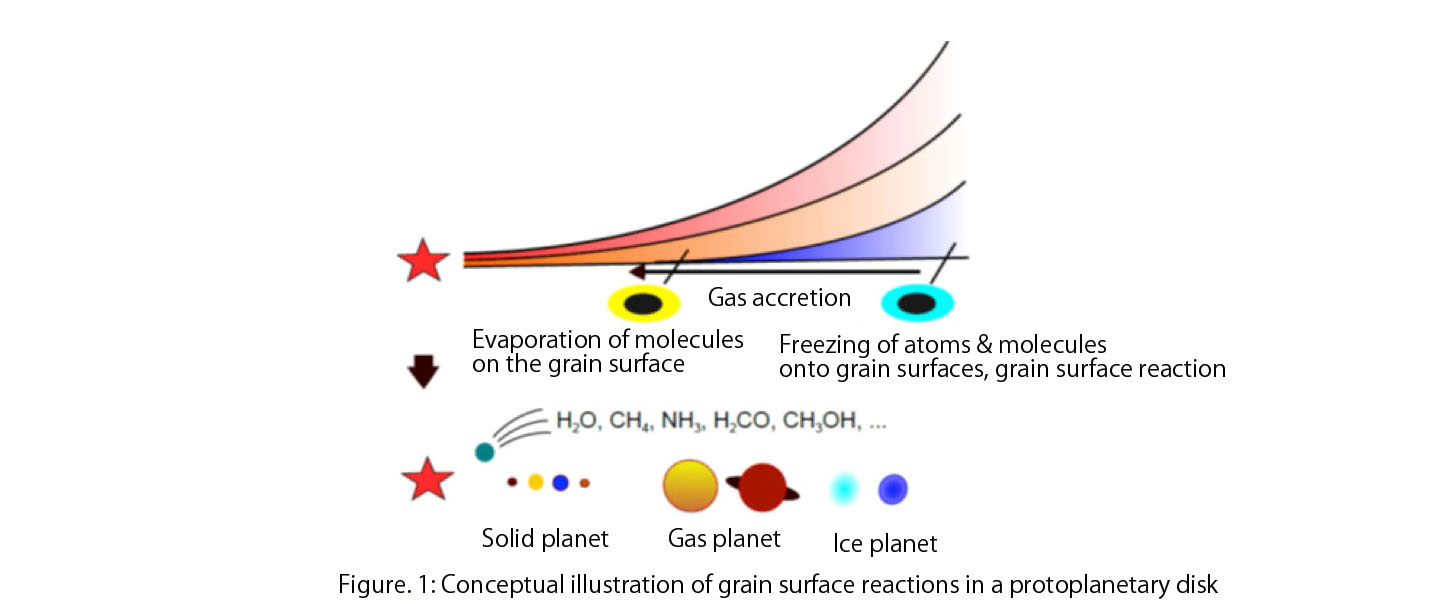Home > Researcher Columns > Searching for the Materials of Life
Searching for the Materials of Life
In material terms, life can be regarded as an aggregate of molecules. It is thought that most of the elements needed to comprise life were produced in stars like the sun. When the cosmos originally came into being, only light elements such as hydrogen and helium existed in space, and heavier atoms such as carbon and oxygen were produced later due to nuclear fusion reactions of atoms inside stars. Elements produced in this way are released into space when a star ends its life span. The released elements are incorporated into regions of space with comparatively high density called molecular clouds, and it is thought that planetary systems like our solar system and extrasolar planetary systems were formed in such molecular clouds.
As of 2015, a diverse variety of over 170 molecular species have been found in molecular clouds, but most of these are small molecules comprised of only a few atoms. Even when the discovered molecules are regarded as complex organic molecules, almost all are comprised of 6–8 atoms at most. Glycine, the simplest of the amino acids which comprise proteins, is made up of 10 atoms, and the organic molecules found in interstellar space are even simpler than glycine. On the other hand, many amino acids more complex than glycine have been found in meteorites in the solar system.
Also, NASA’s “Stardust” comet sample return mission found glycine on a comet. Our group is studying how the complex organic molecules found on objects in the solar system are produced from small molecular species like those found in molecular clouds. Generally speaking, interplanetary space is at low temperature, and the gas-phase chemical reactions which occur in a warm environment like the earth do not take place, for the most part, because the barrier of the activation energy cannot be overcome in interplanetary space. In order to form complex organic molecules in this sort of interplanetary space, it is thought that reactions need to occur on the surface of interplanetary dust grains. Chemical reactions which rarely occur at all in the gaseous phase at low temperature can proceed efficiently if the surface of interplanetary dust is used as a catalyst.
These reactions on the surface of interplanetary dust grains are extremely sensitive to temperature. Here, the primary heat source for the protoplanetary disk which later evolves into a planetary system is radiation from the central star, and temperature is determined by the distance from the star. Therefore, it is thought that a variety of interplanetary grain surface reactions occur depending on distance from the central star. Taking the solar system as a reference, it is likely that reactions where hydrogen is added to an atom or molecule occur on the surface of interplanetary dust in the low temperature region (about –260ºC) outside of Neptune. This is because, at low temperatures, only light elements like hydrogen can move efficiently over the grain surface, and react with other atoms and molecules. In the comparatively warm region near Neptune (temperature about –240ºC) it becomes possible for somewhat heavy atoms and molecules to move over the grain surface. On the other hand, it becomes impossible for light hydrogen to stay on the grain surface, and it is desorbed into the gas phase. As a result, molecules with low hydrogen content are also formed on the grain surface. Inside of the snow line near the asteroid belt, ice (H2O) which covers interplanetary dust is also desorbed into the gas phase, and it is thought that the only large molecules remain on the grain surface, i.e., those which are desorbed into the gas phase less readily than ice (Fig. 1).

Our group is investigating what sort of organic molecules can be formed in which regions of the disk, by carrying out model computations of chemical reactions which occur inside the protoplanetary disk (Fig. 2). By observing radiation from organic molecules in protoplanetary disks using the ALMA large radio telescope in Chile, South America, and comparing the results with our model calculations, we hope to verify grain surface reactions within disks, and investigate how it was possible for organic molecules to be brought to the earth from the protoplanetary disk.

Hideko Nomura (TITECH)
